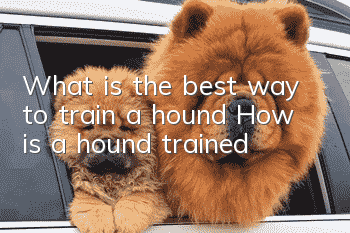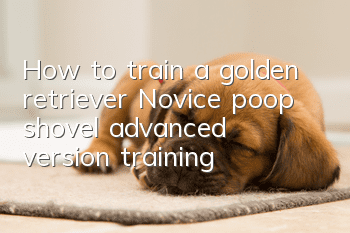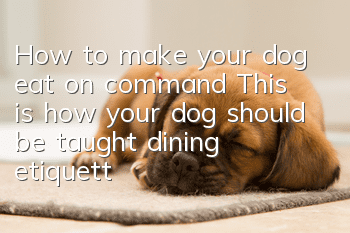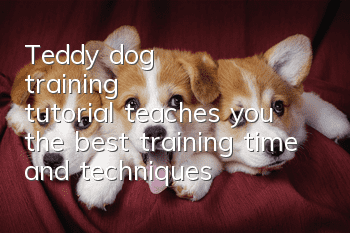What is the best way to train a hound? How is a hound trained?

Principles of hound training
(1) The importance of training; part of the hunting skills of hounds are inherited and part are strictly trained at an early age. A qualified hunting dog often comes from the hard work of a hunter trainer. Without strict, continuous and timely training, no good breed dog can become a good hunting dog. Therefore, hunting dog training is very important.
(2) Specialist training: Training of hounds must start from the young age of the dog, with a dedicated person responsible, and the dog owner cannot be changed midway. If you change the dog head coach midway, it will be difficult to achieve satisfactory success. Not to mention you can't keep it for two days and let it play with it for a while. This will inevitably distract the energy of the puppy and seriously affect the improvement of hunting ability. If you treat a puppy as a plaything, it will only be a dog for fun when it grows up.
(3) Training items and training time; an excellent hound must possess the three hunting skills of searching, chasing, and picking up prey. Therefore, tracking and searching, chasing and attacking, and picking up prey are the focus of training. The purpose of training is to form a strong hunting conditioned reflex in the minds of puppies and learn these three hunting skills so that they can complete the hunting tasks assigned to them by hunters in the future. The six, seven, and eight months after a puppy is born are the fastest period for its advanced neurological development, and it is also the golden period for training puppies in hunting movements. At this time, the puppies must undergo strict and systematic training so that they can have good hunting conditioned reflexes. After one year, the development of the hound has been completed, the quality of the hound has been determined, and retraining is very difficult.
(4) Training place; the primary training of puppies can be carried out in hunting areas, such as wide courtyards, rural threshing grounds, idle areas outside the village, etc., but hound sports training must be carried out in real mountain forest hunting grounds. . Through training in the hunting grounds, the hunting ability of the hounds has been fully developed. Puppy trainers learn to search, hunt, attack and capture prey to overcome activities that are inconsistent with hunting requirements. The more puppies participate in actual hunting training, the better their hunting skills become. Therefore, hunters should always guide their puppies when training their hunting dogs.
(5) Basic methods; The basic methods for training hounds are encouragement and coercion. Encourage the development of its hunting movements and force it to correct activities that do not meet the hunting requirements. To this end, we should talk about combining encouragement and force as the basic method of training hounds. Encouragement methods include luring. When the puppy completes an action, the hunter must provide meat encouragement in time. If the puppy is timid and dare not go into the water to pick it up, the hunter must drag the puppy into the water. When hunters use encouragement or coercion to train puppies, they must be gentle and cannot kick or hit them at will. When the puppy's activities do not meet the requirements for hunting, the hunter must stubbornly and repeatedly correct its wrong actions, and patiently teach it the predetermined hunting actions. It must not be accommodating and indulgent, otherwise, it will leave bad defects on the hunting dog. , affecting future hunting.
(6) You cannot ask hounds beyond the scope: hounds only have a certain primary accumulation of experience and the ability to control their own behavior. It is wrong to compare these behaviors of hounds with human thoughts and behaviors. Therefore,Do not make unrealistically high demands on hounds.
Puppy training subjects
The primary training period for puppies is from 2 months to 6 months after birth.
(1) Training to obey the owner’s orders; the primary training of hunting dogs should start from two months after the puppy is born. During this period, the puppy’s brain nerves begin to develop. Through training, the developing nerves of the puppy can form hunting Required conditioned reflexes. The months of June, July, and August are the fastest period for puppies' advanced neurological development, and they are also the best period for training. After ten months, the hound's development has matured and its hunting performance has been finalized. It is already very difficult to train again. For this reason, the puppy should be weaned at two months, brought back and fed alone, and given a simple and loud name, such as "Little Yellow", "Saihu", "Little Black", etc. The hunter can call it at any time. Help the puppy's developing brain to remember its name firmly. Every time "feeding", the hunter should call the puppy's name so that the puppy can develop the good habit of obeying the command and coming immediately. He should also call frequently with a whistle so that the puppy can develop the habit of coming when it hears the owner's whistle. Conditioned reflex, which is very important for future forest hunting. When puppies learn some simple actions, the training distance should be gradually increased, and the encouragement of stroking or tapping the forehead should gradually be used instead of food lures. The orders issued by the hunter must be simple and precise. Such as "go", "come back"...it must be trained repeatedly and frequently to form a strong conditioned reflex. When the puppy grows to five or six months, it must be trained in hunting skills. First, it must be taught to accurately execute " "Get up", "Don't move", "Lie down", "Chase", "Bite" and other hunting commands. The puppy accurately executed these hunting commands. The hunter should stroke and encourage it, and also reward it with some good food to make it Willing to carry out the master's orders.
(2) Training to follow the owner: Puppies are very friendly to people and are willing to follow their owners. Therefore, it is easier to train puppies to follow their owners. At first, they can be lured with food, and gradually they will love to follow their owners even without food temptations. . However, in order for the puppy to be able to follow its owner closely without running around, it must be done through repeated training. When it is first trained to follow, the puppy is very novel about the surrounding scenery. Sometimes it will run away to smell and watch. The hunter must call it back immediately. If necessary, take coercive measures to teach the puppy to follow with a leash. After getting used to it, remove the collar, and finally train the puppy to have a good habit of walking beside the owner.
(3) Cultivation of the courageous quality of hounds; three months after the puppies are born, hounds should be taken to the wild to familiarize themselves with natural environments such as mountains and forests to cultivate the courage of the puppies.Dare quality. A good-breed puppy can turn into a cowardly, useless bad dog if it is chained at home all day long. On the contrary, if the breed of puppy is not very good, if it can be practiced regularly, hunters often take the dog to the mountains and forests for activities, and will train a good hound that is brave and capable. Take your puppy outdoors and don't be afraid of losing it. Call him from time to time to prevent him from moving alone, which is not conducive to training the hunting performance of the hound. If the puppy goes too far, the hunter's shouts and whistles will not make it turn around immediately. The hunter should stand in the same spot and wait for him. The puppy will find its owner on its own. If the puppy finds a hunter, the hunter will encourage it; if it cannot find its owner, the hunter will take the initiative to say hello to it. In order to cultivate the courageous qualities of the puppy, the puppy should also be accustomed to the sound of gunshots in the wild. If the puppy is afraid of being shot, the hunter should take care of it and touch it. As long as he hears gunshots often in the future, he will slowly adapt. In order to cultivate the brave character of the puppy, the hunting dog should be allowed to smell the scent of wild animals from an early age. In order to make a dog food bowl, we need to find some animal skins to smell and rub them to cultivate students' sense of smell and enthusiasm for hunting animals, and lay the foundation for hunting, tracking, reconnaissance and hunting. If conditions permit, the puppy will be required to eat fresh animal meat regularly after six months. When it is given food, it is asked to smell it before eating. In the future, the scent of the beast will not scare him, but will stimulate the hound to chase him bravely. In order to cultivate the brave qualities of the puppy, when the puppy goes out to hunt after six months, the command should be strengthened and taught to search and attack. However, puppies have limited physical strength and inexperience. The hunter should consciously arrange several victories for the puppy. For example, when other hounds knock down a wild boar, the hunter should instruct the puppy to take a few more bites. Or when the wild boar is still struggling, this is a good way to increase the courage of the puppy and get a few more bites.
(4) Coaching of hound picking up skills: After the puppies grow to four months, the hunter should throw objects in the courtyard or threshing floor to train the puppies to pick up. At first, the puppy often bites the things it picks up. The hunter should stop it immediately and order it to hand over the things it picked up to its owner. To make the puppy willing to complete this action, it must first be achieved by using food to induce it. The dog's picking up training should start from near to far. After the simple picking up task is completed, the dog should be trained to complete the complex picking up task, such as throwing objects into the water, training it to swim and pick up; or throwing things into the water. In the grass, the puppies are coached to complete the fetching task in complex situations. When training puppies to pick up, the first step is to use food to lure them, and gradually change to petting and encouragement, so that the dogs can form a strong conditioned reflex. In order to lay the foundation for future hunting pick-ups, the picked-up items can gradually be replaced with dead animals. The hunter throws out the dead birds and beasts and orders the puppies to pick them up and hand them back to the owner. This is the same as training the puppies to pick up ordinary objects. When the puppies complete this action, the hunter will immediately reward them with meat. From near to far, gradually increase the picking distance, and repeat the training until the puppy completes the command every time, and then go to the hunting ground for hunting and picking up training. Training for hunting bit picking should be carried out at the hunting ground. Kill the hare,If a bird is shot down, the hunter should not pick it up, but order the puppy to pick it up and bring it back. After the puppy completes this action, the hunter must immediately cut a piece of fresh meat from the bird or beast picked up by the puppy to reward it. As long as this method is repeated many times for training, the puppies will be able to form a strong conditioned reflex and this hunting ability can be consolidated. If the puppy is timid when searching and picking up prey in the hunting ground, the hunter should lead the puppy to search together. After several such field trainings, the puppy will be bolder and dare to complete the task of picking up the prey alone. It is not difficult to train puppies to hunt in the wild, but the hunter must persevere to achieve satisfactory results.
(5) The cultivation of hunting ability of hounds. In the wild, the cultivation of hunting ability of puppies in searching for wild animals must be carried out by two hunters. A hunter first drags the dead bird or beast on the ground, and then the owner of the hound orders the hound to search for it. If the puppy finds the dead bird or beast, the hunter must immediately reward it with a piece of fresh meat, or Encourage it by stroking its forehead. From near to far, gradually increase the distance. After the puppy can complete the task every time, it is time to conduct on-site tracking training in the hunting ground. Fall without snow is the best season to train puppies to track. Hunters take puppies to the hunting ground for field training. The hunting ground should be chosen in a place where there are not too many hares. If there are too many hares, they will keep startling and the trails will be confusing, which is not conducive to training. During training, when a hare is startled, the hunter should wait for the hare to escape and then lead the hunter to follow it. Sometimes the puppy loses its trace and is in a state of hesitation and "stuck". The place where the trace is lost is often behind the hound's "stuck" state of hesitation. The hunter can re-find the hare's footprints by taking the hound back a short distance. . If the puppy cannot be found, the hunter needs specific help; or the hunter finds the rabbit trail, points it out to the hound, and then orders the hound to continue looking for the rabbit; or the hunter takes the hound around the "stuck" place a few times and removes the rabbit trail. The hare coaxed it up, and then asked the puppy to continue searching. Under no circumstances should the puppies be asked to give up the trail of this rabbit and chase other rabbits. This will cause the puppies to develop the bad habit of losing track.
Precautions for training puppies to track
① It is not allowed to chase down. If there is such a problem, the hunter must correct it forcefully and resolutely.
②The hound followed this trace and discovered another new trace. It is not allowed to abandon the original one and chase the newly discovered one. Otherwise, if you lose the original one and chase the other, you will keep losing and changing, and ultimately nothing will be accomplished.
③ Training puppies to track in the snow is convenient for hunters to observe and guide, and seems to be beneficial, but it is not good for hounds. The scent of animal tracks in the snow is weak, and hounds rely on smell, not vision, to identify traces. Hunters must pay attention.
④ Wild tracking training must enable hounds to develop long-lasting endurance. A keen sense of smell and the ability to never lose sight of animals are valuable advantages of hounds.
- How to train dogs to delay. Sit, lie and stand: basic delay training for dogs.
- Training a Schnauzer to defecate in a fixed place. How many days does it take for a dog to learn to defecate at a fixed place?
- Tips for cooling down your dog in summer Five tips to help your dog cool down in the hot summer
- What to do if your dog gets carsick? Tips and taboos for taking your dog in the car
- Reasons why dogs eat grass. Dogs bite weeds because they eat too few vegetables.
- How to teach a dog to pick up things. Stop envying other people’s dogs.
- Things to note when raising a dog: Six things you need to do when raising a pet dog
- How to teach a dog to roll? Does your dog know how to roll and pretend to be dead?
- How to make a dog obedient? Three easy tips to teach you how to train a well-behaved dog
- Common skin diseases in dogs Five common skin diseases in dogs and their treatments



